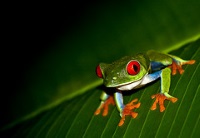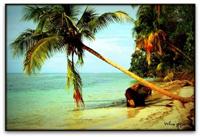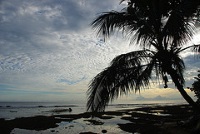Things to do in The Caribbean Lowlands
The main attractions of the Caribbean coastline of Costa Rica are the beaches but this side of the country also offers pristine rainforests, plenty of wildlife watching opportunities, and some lovely, laid-back beach villages. The Caribbean charm is fully evident in Costa Rica and the slow pace of life, great music, and friendly locals make this coastline very relaxed.
The southern Caribbean coast is the best for enjoying the beautiful beaches of the area. Favourite tourist beaches include Playa Bonita, Playa Cocles, Playa Chiquita and Punta Uva. Puerto Viejo de Talamanca is a small but vibrant party town nestled in between the mountains and the coast, popular for its surfing, sun-worshipping, and nightlife.
Cahuita National Park, also in the south, shelters the only coral reef on Costa Rica's Caribbean coastline and is a paradise for diving and snorkelling. On the hike through the jungle to reach the beach, you are likely to see numerous birds and monkeys. The town of Cahuita, just outside the park, is also a popular base for exploring the coast and is well-known for its local music scene.
The northern coast is ideal for those in search of wildlife. Tortuguero National Park is one of the most famous attractions in Costa Rica. It is home to an impressive array of fauna (50 percent of Costa Rica's species can be found here) and it is one of the best places in the world to witness the hatching of green sea turtles. Visitors can seek the animals out on numerous land and water trails.
The Caribbean coast is less developed for tourism than the Pacific side, which is its main advantage for many visitors seeking an authentic Costa Rican experience. However, there is plenty to see and do on the Caribbean coast if visitors can drag themselves away from the wonderful beaches.

Tortuguero National Park
Despite its isolation on the northern part of the Caribbean coast, Tortuguero National Park is an extremely popular destination and one of the most important nesting sites of the g…
Tortuguero National Park
Despite its isolation on the northern part of the Caribbean coast, Tortuguero National Park is an extremely popular destination and one of the most important nesting sites of the green sea turtle, which lays its eggs here between July and October each year. Three other turtle species also use the beach as a nesting ground, namely the giant leatherback, hawksbill, and loggerhead turtles. The park covers an area of over 120 square miles (189 sq km), protecting not only the turtle beach, but also wetlands, swamps, forests, and one of the most developed reefs in the country. Nature trails in the park offer opportunities for wildlife viewing and birding and a network of waterways serves as an alternative method of transportation and exploration. Approximately 50 percent of Costa Rica's bird and reptile species are found in the park along with a diversity of flora and fauna, including endangered mammals such as the jaguar, sloth, tapir, and manatee. Most visitors come to watch the spectacular sight of thousands of marine turtles laying their eggs or to observe the hatching.
Website www.acto.go.cr

Cahuita National Park
The only coral reef on the Costa Rican Caribbean coastline is found within this national park and, with 500 species of fish, it affords excellent opportunities for snorkelling. Apa…
Cahuita National Park
The only coral reef on the Costa Rican Caribbean coastline is found within this national park and, with 500 species of fish, it affords excellent opportunities for snorkelling. Apart from the vibrant underwater colours and fish, there are two sunken ships to explore as well. The park was established in 1970 to protect the coral reef, but unfortunately it is still seriously threatened. While the land area of Cahuita National Park is small, it has stunning beaches and is good for both land and water activities, making it one of the most visited parks on the Caribbean coast. A well-defined trail runs through the coastal rainforest and howler monkeys and sloths are among the wildlife attractions. The area is also great for bird watching and may reward visitors with sightings of the striking blue butterflies found in the jungle. The hike to the beach is flat and the path is easy to follow and winds through wonderful jungle scenery.

Puerto Viejo de Talamanca
Puerto Viejo de Talamanca, known to locals as Puerto Viejo (not to be confused with Puerto Viejo de Sarapiquí in the northern lowlands), is a dusty little village lying between th…
Puerto Viejo de Talamanca
Puerto Viejo de Talamanca, known to locals as Puerto Viejo (not to be confused with Puerto Viejo de Sarapiquí in the northern lowlands), is a dusty little village lying between the forested mountains of Talamanca and the sea. The little town offers excellent surfing, an interesting mix of Afro-Caribbean and Bribri indigenous cultures, and delicious local food. The seven miles (12km) of coastline between Puerto Viejo and Manzanillo further east is one of the most stunning stretches in Costa Rica, featuring popular beaches such as Playa Cocles, Playa Chiquita and Punta Uva. There are many other activities in the area, including fishing and horse riding, cultural tours and home stays, as well as excursions to the nearby Cahuita National Park. Puerto Viejo has a vibrant nightlife and great local music, meaning it's a good base for those who enjoy a party.



